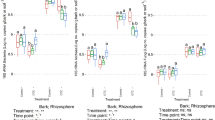Abstract
Pittosporum tobira L. (Family Pittosporaceae) is an important plant species grown in parks and gardens in Turkey. The cottony cushion scale, Icerya purchasi Maskell (Homoptera: Coccina, Margarodidae), is an important pest of P. tobira, and causes damage mainly to the leaves, branches and stems of the host plant. In spite of the great economic importance of I. purchasi to its host plant P. tobira, information has been limited on some basic anatomical parameters of the nature of the damage to leaves and branches. The present study was, therefore, initiated to investigate the insertion and penetration of stylets into the leaves and branches of P. tobira, the length of stylets and depth of penetration in both of these tissues, and penetration of stylets into the cortex, xylem and phloem tissues and into the secretory and non-secretory canals of the leaves and branches. The results showed great variations between the leaves and branches in all the criteria observed in I. purchasi infesting P. tobira. The study found 20 whole and 23 broken mouthparts in the leaves as compared to 3 whole mouthparts and 1 broken in the branches. Length of the stylets inserted into the leaves ranged from 33.83 μm to 540.93 μm and into the branches from 202.85 μm to 340.8 μm. The stylets reached greater depths in the leaves, at 540.93 μm, as compared to 498.67 μm in the branches. The stylets in the leaves were associated with 12 secretory canals, but with none in the branches. It was found that three stylets reached xylem in the leaves as compared to one in the branches. Similarly, 17 stylets in the leaves reached to the phloem, but only 2 in the branches. No stylets were found in the cortex of the leaves, but one was found in the branches. In the leaves, 11 stylets reached and remained in the non-secretory canals, but none in the case of the branches.

Similar content being viewed by others
References
Aysu R (1957) Studies on the biology of Icerya purchasi Maskell. Mon J Plant Dis Pest Control 63:1–21
Bailey LH (1964) Manual of cultivated plants. Macmillan, New York, pp 488–489
Bodenheimer FS (1951) Citrus entomology, vol I. The citrus fluted scale (Icerya purchasi Maskell). Junk, s’ Gravenhage
Charles Darwin Foundation and the Charles Darwin Research Station (2001) Biological control of the Cottony cushion scale, Icerya purchasi, in Galapagos. http://darwinfoundation.org/news/news12080102.html
Department of Entomology and Nematology, University of Florida (1998) Featured Creatures—Cottony cushion scale Icerya purchasi Maskell. http://creatures.ifas.ufl.edu/fruit/cottony_cushion_scale.htm
Department of Entomology, Texas A&M University (1999) Cottony cushion scale. http://insects.tamu.edu/fieldguide/bimg116.html
Erhard P (1963) Untersuchungen über Bau und Funktion des Verdauungstraktes von Megoura vicia Buckt. (Homoptera: Aphidae) unter besonderer Berücksichtigung der Nahrungsaufnahme und der Honigtauabgabe. Z Morphol Ökol Tiere 52:597–677
Gilmour D (1965) The metabolism of insects. Freeman, San Francisco
Institut National de la Recherche Agronomique, HYPP (Hypermédia en protection des plantes) (1998) Australian mealybug, Fluted scale. http://www.inra.fr/Internet/Produits/HYPPZ/RAVAGEUR/6icepur.htm
Metcalfe CR, Chalk L (1957) Anatomy of the dicotyledons, vol I. Clarendon, Oxford
Moericke V, Mittler TE (1966) Oesophageal and stomach inclusions of Aphids feeding on various cruciferae. Entomol Exp Appl 9:287–297
Moericke V, Wohlfahrt-Bottermann KE (1963) Zur funktionellen Morphologie der Speicheldrüsen von Homopteren. II. Mitteilung: Die Deck- und Zentralzellen der Speicheldrüse vom Myzus persicae (Sulz.), Aphididae. Z Zellforsch 59:165–183
Nizamlioglu K (1957) Fruit tree pests and control in Turkey. Koruma Tarim Ilaclari , pp 169–170
Pirone PP, Dodge BO, Rickett HW (1960) Diseases and pests of ornamental plants, vol I, 3rd edn. Ronald, New York
Schlein Y, Jacobson RL (1994) Mortality of Leishmania major in Phlebotomus papatasi caused by plant-feeding of the sand flies. Am J Trop Med Hyg 50:20–27
University of California Statewide Integrated Pest Management Program (2003) UC Pest Management Guidelines—Cottony cushion scale. http://www.ipm.ucdavis.edu/PMG/PESTNOTES/pn7410.html#DAMAGE
Acknowledgement
The author is grateful to M.Sc. Imtiaz Ali Khan for the correcting the English of this paper.
Author information
Authors and Affiliations
Corresponding author
Rights and permissions
About this article
Cite this article
Tort, N. A study on some anatomical parameters of the piercing-sucking process in leaves and branches of Pittosporum tobira L. (Pittosporaceae) infested by the cottony cushion scale, Icerya purchasi Maskell (Homoptera: Coccina, Margarodidae). J Pest Sci 77, 53–56 (2004). https://doi.org/10.1007/s10340-003-0028-z
Received:
Published:
Issue Date:
DOI: https://doi.org/10.1007/s10340-003-0028-z




